Comprehensive Report on Finance and Funding in Travel & Tourism Sector
VerifiedAdded on 2020/10/22
|16
|3299
|460
Report
AI Summary
This report delves into the crucial aspects of finance and funding within the travel and tourism sector. It begins by highlighting the importance of cost and volume analysis in financial management, particularly for a Wild Life Trust, illustrating how these elements impact profitability through examples such as income statements and break-even point calculations. The report then explores various pricing methods, including seasonal pricing, discounted pricing, and package deals, essential for revenue generation in the industry. Furthermore, it identifies both internal factors, such as events, and external factors, like environmental and economic conditions, that influence profitability. The report also examines different types of management accounting information, such as budget reports, cost managerial accounting reports, and performance reports, detailing their use in decision-making processes. Finally, the report provides an interpretation of financial accounts, including ratio analysis (current ratio, quick ratio, return on assets, etc.), to assess the financial health of a travel and tourism entity, like the Berkshire, Buckinghamshire, and Oxfordshire Wildlife Trust, and discusses sources of funding for capital projects. The report provides a comprehensive overview of financial management and its application in the travel and tourism sector.
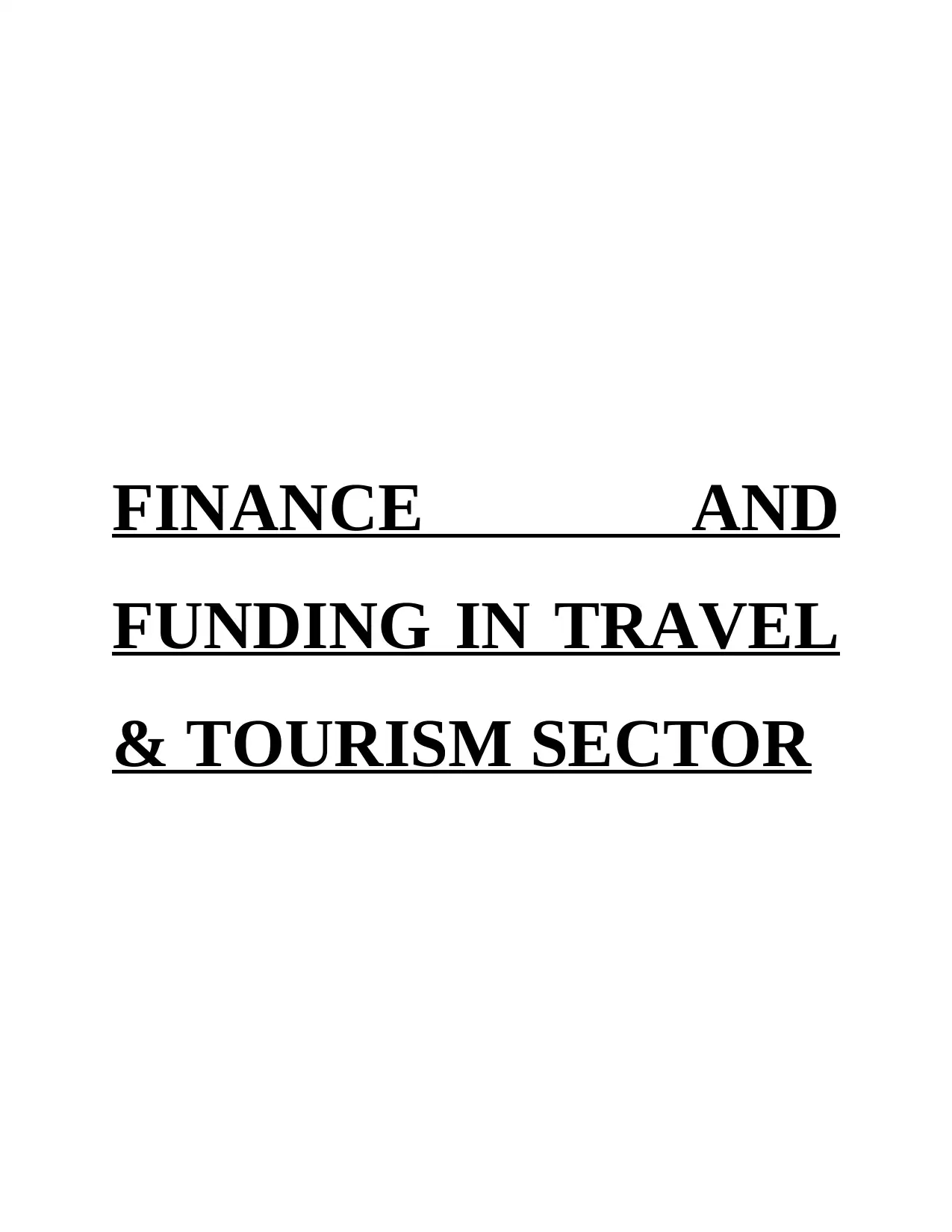
FINANCE AND
FUNDING IN TRAVEL
& TOURISM SECTOR
FUNDING IN TRAVEL
& TOURISM SECTOR
Paraphrase This Document
Need a fresh take? Get an instant paraphrase of this document with our AI Paraphraser
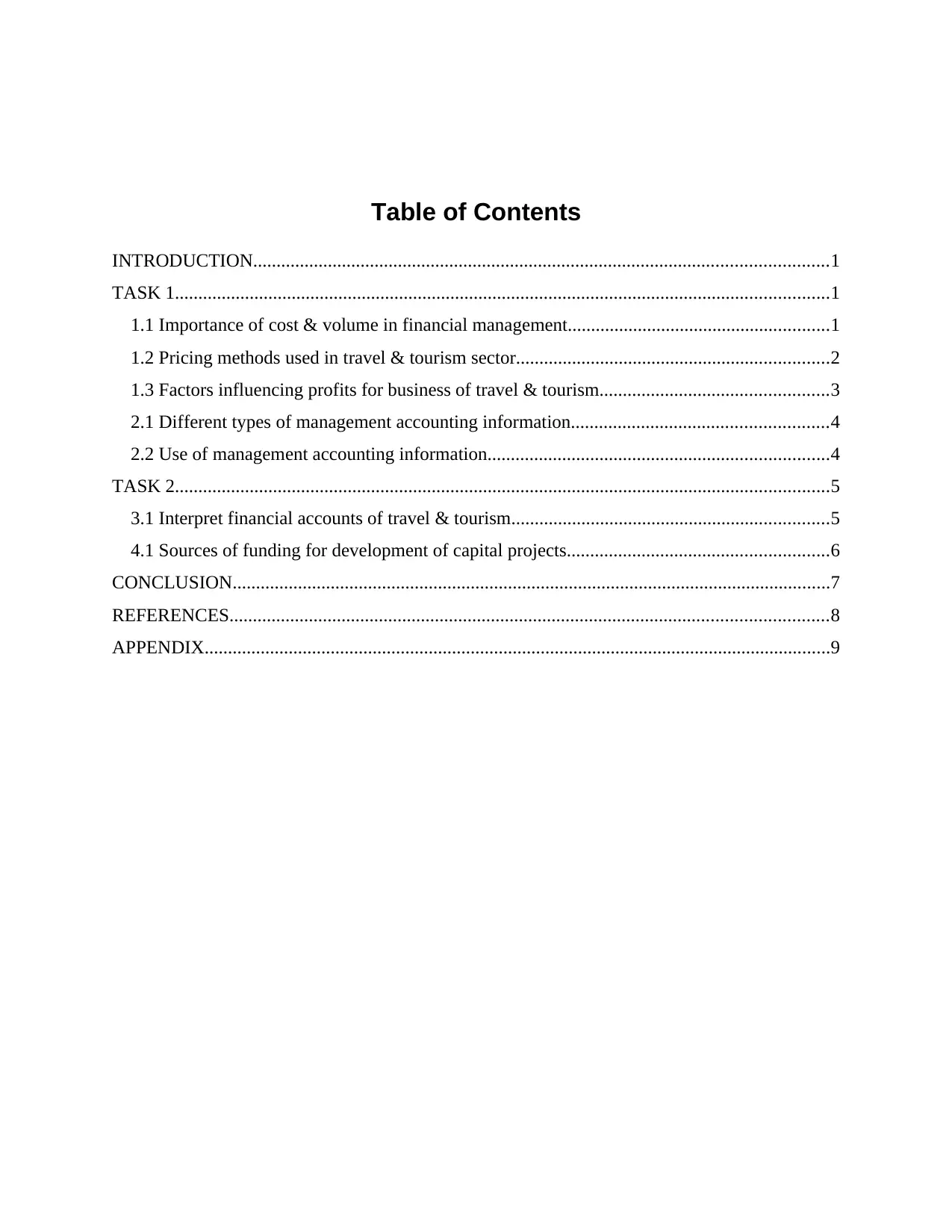
Table of Contents
INTRODUCTION...........................................................................................................................1
TASK 1............................................................................................................................................1
1.1 Importance of cost & volume in financial management........................................................1
1.2 Pricing methods used in travel & tourism sector...................................................................2
1.3 Factors influencing profits for business of travel & tourism.................................................3
2.1 Different types of management accounting information.......................................................4
2.2 Use of management accounting information.........................................................................4
TASK 2............................................................................................................................................5
3.1 Interpret financial accounts of travel & tourism....................................................................5
4.1 Sources of funding for development of capital projects........................................................6
CONCLUSION................................................................................................................................7
REFERENCES................................................................................................................................8
APPENDIX......................................................................................................................................9
INTRODUCTION...........................................................................................................................1
TASK 1............................................................................................................................................1
1.1 Importance of cost & volume in financial management........................................................1
1.2 Pricing methods used in travel & tourism sector...................................................................2
1.3 Factors influencing profits for business of travel & tourism.................................................3
2.1 Different types of management accounting information.......................................................4
2.2 Use of management accounting information.........................................................................4
TASK 2............................................................................................................................................5
3.1 Interpret financial accounts of travel & tourism....................................................................5
4.1 Sources of funding for development of capital projects........................................................6
CONCLUSION................................................................................................................................7
REFERENCES................................................................................................................................8
APPENDIX......................................................................................................................................9
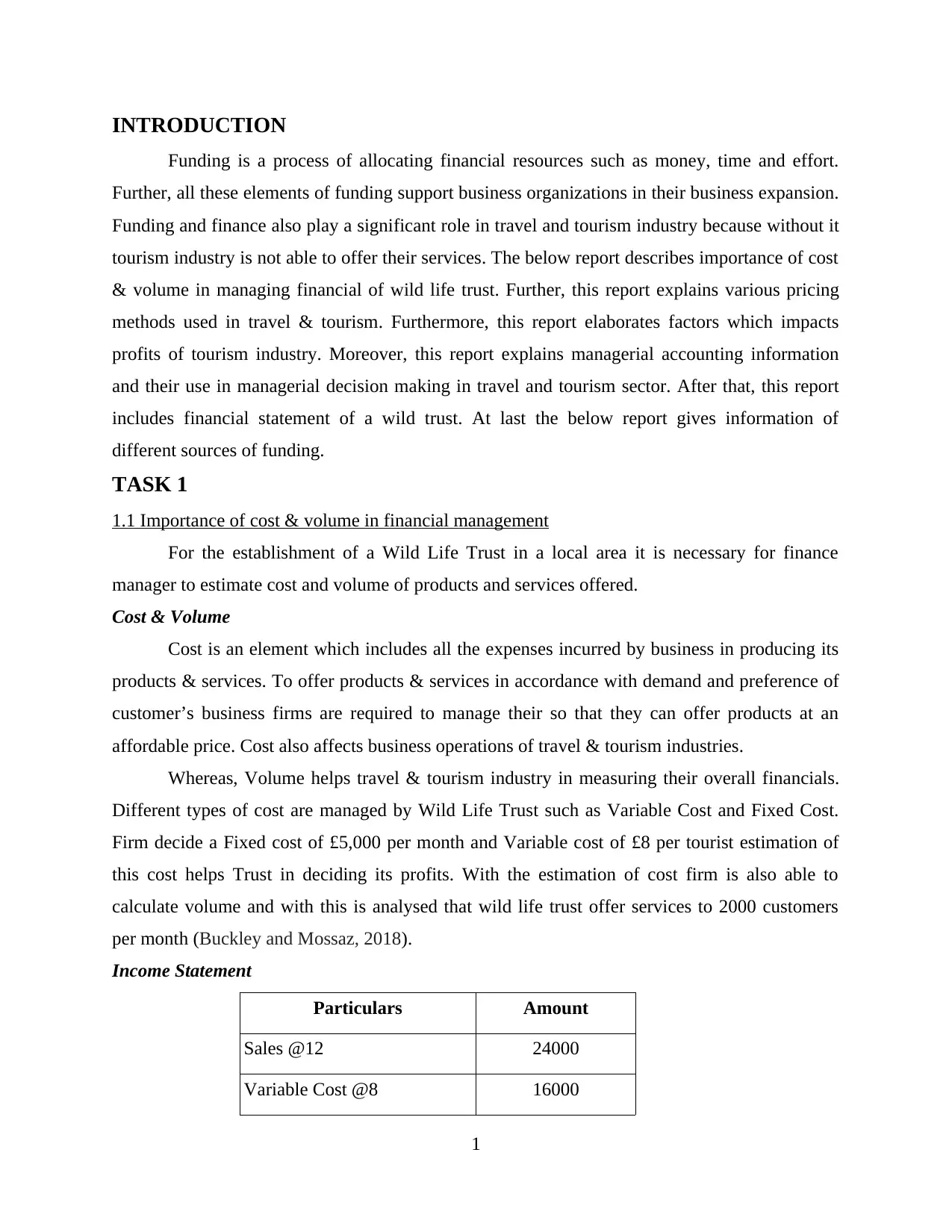
INTRODUCTION
Funding is a process of allocating financial resources such as money, time and effort.
Further, all these elements of funding support business organizations in their business expansion.
Funding and finance also play a significant role in travel and tourism industry because without it
tourism industry is not able to offer their services. The below report describes importance of cost
& volume in managing financial of wild life trust. Further, this report explains various pricing
methods used in travel & tourism. Furthermore, this report elaborates factors which impacts
profits of tourism industry. Moreover, this report explains managerial accounting information
and their use in managerial decision making in travel and tourism sector. After that, this report
includes financial statement of a wild trust. At last the below report gives information of
different sources of funding.
TASK 1
1.1 Importance of cost & volume in financial management
For the establishment of a Wild Life Trust in a local area it is necessary for finance
manager to estimate cost and volume of products and services offered.
Cost & Volume
Cost is an element which includes all the expenses incurred by business in producing its
products & services. To offer products & services in accordance with demand and preference of
customer’s business firms are required to manage their so that they can offer products at an
affordable price. Cost also affects business operations of travel & tourism industries.
Whereas, Volume helps travel & tourism industry in measuring their overall financials.
Different types of cost are managed by Wild Life Trust such as Variable Cost and Fixed Cost.
Firm decide a Fixed cost of £5,000 per month and Variable cost of £8 per tourist estimation of
this cost helps Trust in deciding its profits. With the estimation of cost firm is also able to
calculate volume and with this is analysed that wild life trust offer services to 2000 customers
per month (Buckley and Mossaz, 2018).
Income Statement
Particulars Amount
Sales @12 24000
Variable Cost @8 16000
1
Funding is a process of allocating financial resources such as money, time and effort.
Further, all these elements of funding support business organizations in their business expansion.
Funding and finance also play a significant role in travel and tourism industry because without it
tourism industry is not able to offer their services. The below report describes importance of cost
& volume in managing financial of wild life trust. Further, this report explains various pricing
methods used in travel & tourism. Furthermore, this report elaborates factors which impacts
profits of tourism industry. Moreover, this report explains managerial accounting information
and their use in managerial decision making in travel and tourism sector. After that, this report
includes financial statement of a wild trust. At last the below report gives information of
different sources of funding.
TASK 1
1.1 Importance of cost & volume in financial management
For the establishment of a Wild Life Trust in a local area it is necessary for finance
manager to estimate cost and volume of products and services offered.
Cost & Volume
Cost is an element which includes all the expenses incurred by business in producing its
products & services. To offer products & services in accordance with demand and preference of
customer’s business firms are required to manage their so that they can offer products at an
affordable price. Cost also affects business operations of travel & tourism industries.
Whereas, Volume helps travel & tourism industry in measuring their overall financials.
Different types of cost are managed by Wild Life Trust such as Variable Cost and Fixed Cost.
Firm decide a Fixed cost of £5,000 per month and Variable cost of £8 per tourist estimation of
this cost helps Trust in deciding its profits. With the estimation of cost firm is also able to
calculate volume and with this is analysed that wild life trust offer services to 2000 customers
per month (Buckley and Mossaz, 2018).
Income Statement
Particulars Amount
Sales @12 24000
Variable Cost @8 16000
1
⊘ This is a preview!⊘
Do you want full access?
Subscribe today to unlock all pages.

Trusted by 1+ million students worldwide
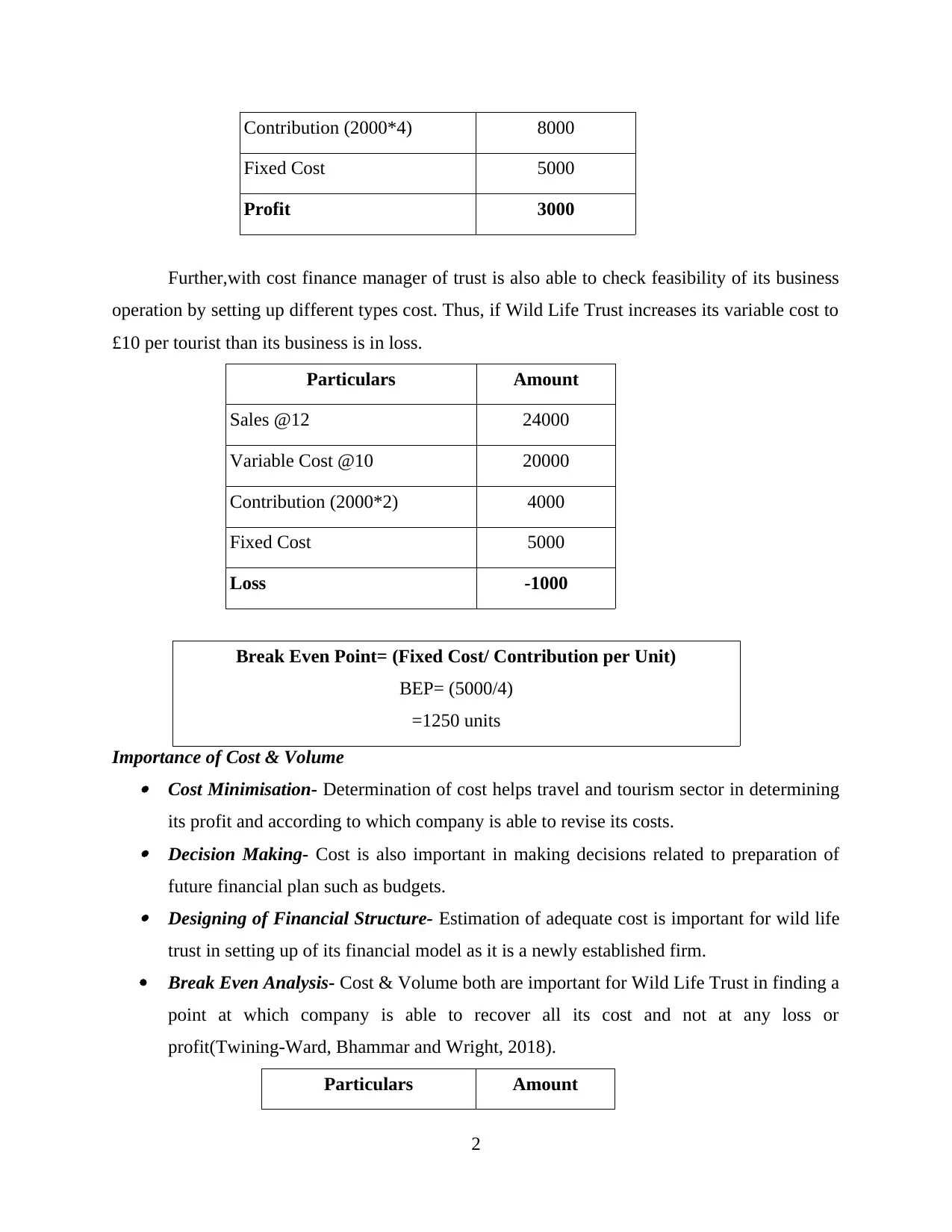
Contribution (2000*4) 8000
Fixed Cost 5000
Profit 3000
Further,with cost finance manager of trust is also able to check feasibility of its business
operation by setting up different types cost. Thus, if Wild Life Trust increases its variable cost to
£10 per tourist than its business is in loss.
Particulars Amount
Sales @12 24000
Variable Cost @10 20000
Contribution (2000*2) 4000
Fixed Cost 5000
Loss -1000
Break Even Point= (Fixed Cost/ Contribution per Unit)
BEP= (5000/4)
=1250 units
Importance of Cost & Volume Cost Minimisation- Determination of cost helps travel and tourism sector in determining
its profit and according to which company is able to revise its costs. Decision Making- Cost is also important in making decisions related to preparation of
future financial plan such as budgets. Designing of Financial Structure- Estimation of adequate cost is important for wild life
trust in setting up of its financial model as it is a newly established firm.
Break Even Analysis- Cost & Volume both are important for Wild Life Trust in finding a
point at which company is able to recover all its cost and not at any loss or
profit(Twining-Ward, Bhammar and Wright, 2018).
Particulars Amount
2
Fixed Cost 5000
Profit 3000
Further,with cost finance manager of trust is also able to check feasibility of its business
operation by setting up different types cost. Thus, if Wild Life Trust increases its variable cost to
£10 per tourist than its business is in loss.
Particulars Amount
Sales @12 24000
Variable Cost @10 20000
Contribution (2000*2) 4000
Fixed Cost 5000
Loss -1000
Break Even Point= (Fixed Cost/ Contribution per Unit)
BEP= (5000/4)
=1250 units
Importance of Cost & Volume Cost Minimisation- Determination of cost helps travel and tourism sector in determining
its profit and according to which company is able to revise its costs. Decision Making- Cost is also important in making decisions related to preparation of
future financial plan such as budgets. Designing of Financial Structure- Estimation of adequate cost is important for wild life
trust in setting up of its financial model as it is a newly established firm.
Break Even Analysis- Cost & Volume both are important for Wild Life Trust in finding a
point at which company is able to recover all its cost and not at any loss or
profit(Twining-Ward, Bhammar and Wright, 2018).
Particulars Amount
2
Paraphrase This Document
Need a fresh take? Get an instant paraphrase of this document with our AI Paraphraser
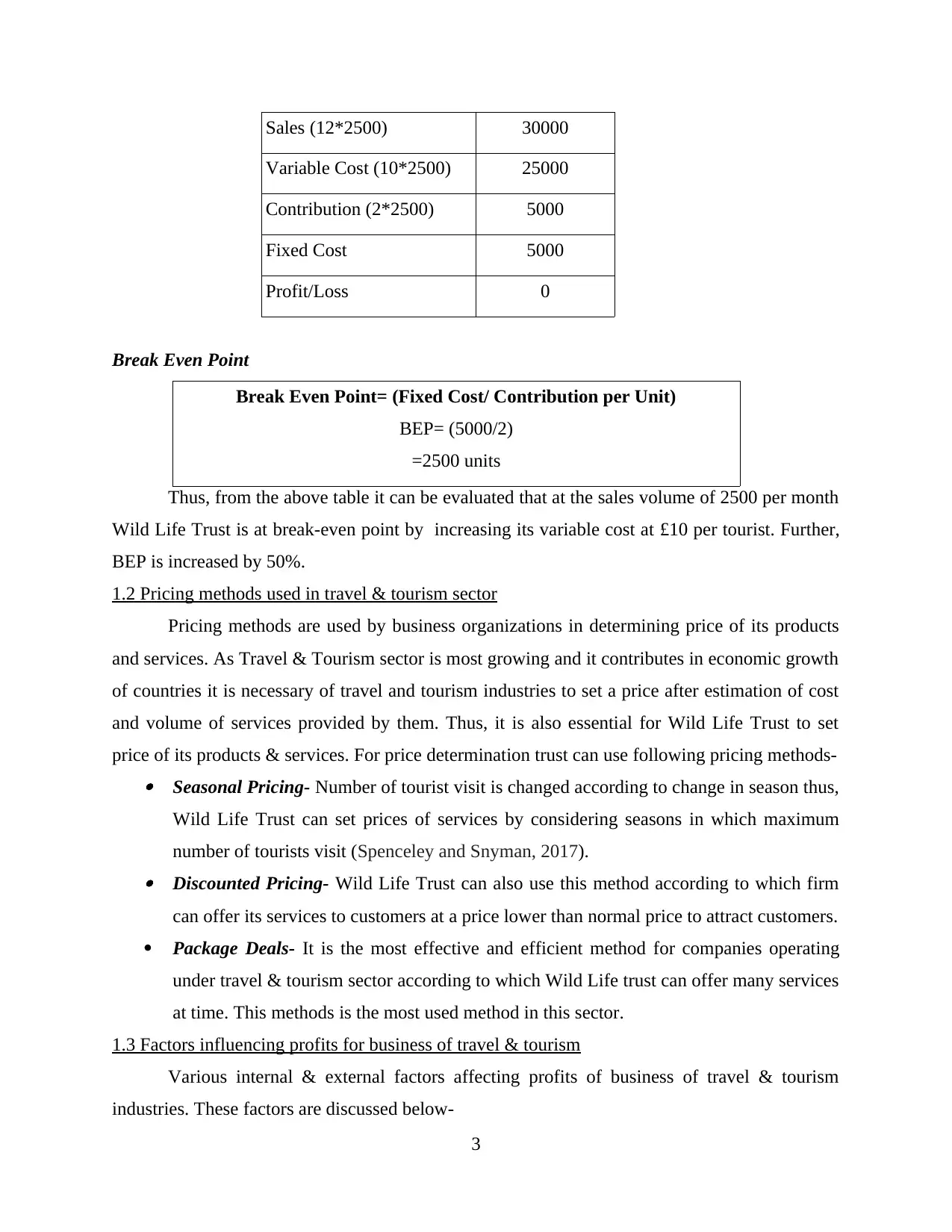
Sales (12*2500) 30000
Variable Cost (10*2500) 25000
Contribution (2*2500) 5000
Fixed Cost 5000
Profit/Loss 0
Break Even Point
Break Even Point= (Fixed Cost/ Contribution per Unit)
BEP= (5000/2)
=2500 units
Thus, from the above table it can be evaluated that at the sales volume of 2500 per month
Wild Life Trust is at break-even point by increasing its variable cost at £10 per tourist. Further,
BEP is increased by 50%.
1.2 Pricing methods used in travel & tourism sector
Pricing methods are used by business organizations in determining price of its products
and services. As Travel & Tourism sector is most growing and it contributes in economic growth
of countries it is necessary of travel and tourism industries to set a price after estimation of cost
and volume of services provided by them. Thus, it is also essential for Wild Life Trust to set
price of its products & services. For price determination trust can use following pricing methods- Seasonal Pricing- Number of tourist visit is changed according to change in season thus,
Wild Life Trust can set prices of services by considering seasons in which maximum
number of tourists visit (Spenceley and Snyman, 2017). Discounted Pricing- Wild Life Trust can also use this method according to which firm
can offer its services to customers at a price lower than normal price to attract customers.
Package Deals- It is the most effective and efficient method for companies operating
under travel & tourism sector according to which Wild Life trust can offer many services
at time. This methods is the most used method in this sector.
1.3 Factors influencing profits for business of travel & tourism
Various internal & external factors affecting profits of business of travel & tourism
industries. These factors are discussed below-
3
Variable Cost (10*2500) 25000
Contribution (2*2500) 5000
Fixed Cost 5000
Profit/Loss 0
Break Even Point
Break Even Point= (Fixed Cost/ Contribution per Unit)
BEP= (5000/2)
=2500 units
Thus, from the above table it can be evaluated that at the sales volume of 2500 per month
Wild Life Trust is at break-even point by increasing its variable cost at £10 per tourist. Further,
BEP is increased by 50%.
1.2 Pricing methods used in travel & tourism sector
Pricing methods are used by business organizations in determining price of its products
and services. As Travel & Tourism sector is most growing and it contributes in economic growth
of countries it is necessary of travel and tourism industries to set a price after estimation of cost
and volume of services provided by them. Thus, it is also essential for Wild Life Trust to set
price of its products & services. For price determination trust can use following pricing methods- Seasonal Pricing- Number of tourist visit is changed according to change in season thus,
Wild Life Trust can set prices of services by considering seasons in which maximum
number of tourists visit (Spenceley and Snyman, 2017). Discounted Pricing- Wild Life Trust can also use this method according to which firm
can offer its services to customers at a price lower than normal price to attract customers.
Package Deals- It is the most effective and efficient method for companies operating
under travel & tourism sector according to which Wild Life trust can offer many services
at time. This methods is the most used method in this sector.
1.3 Factors influencing profits for business of travel & tourism
Various internal & external factors affecting profits of business of travel & tourism
industries. These factors are discussed below-
3
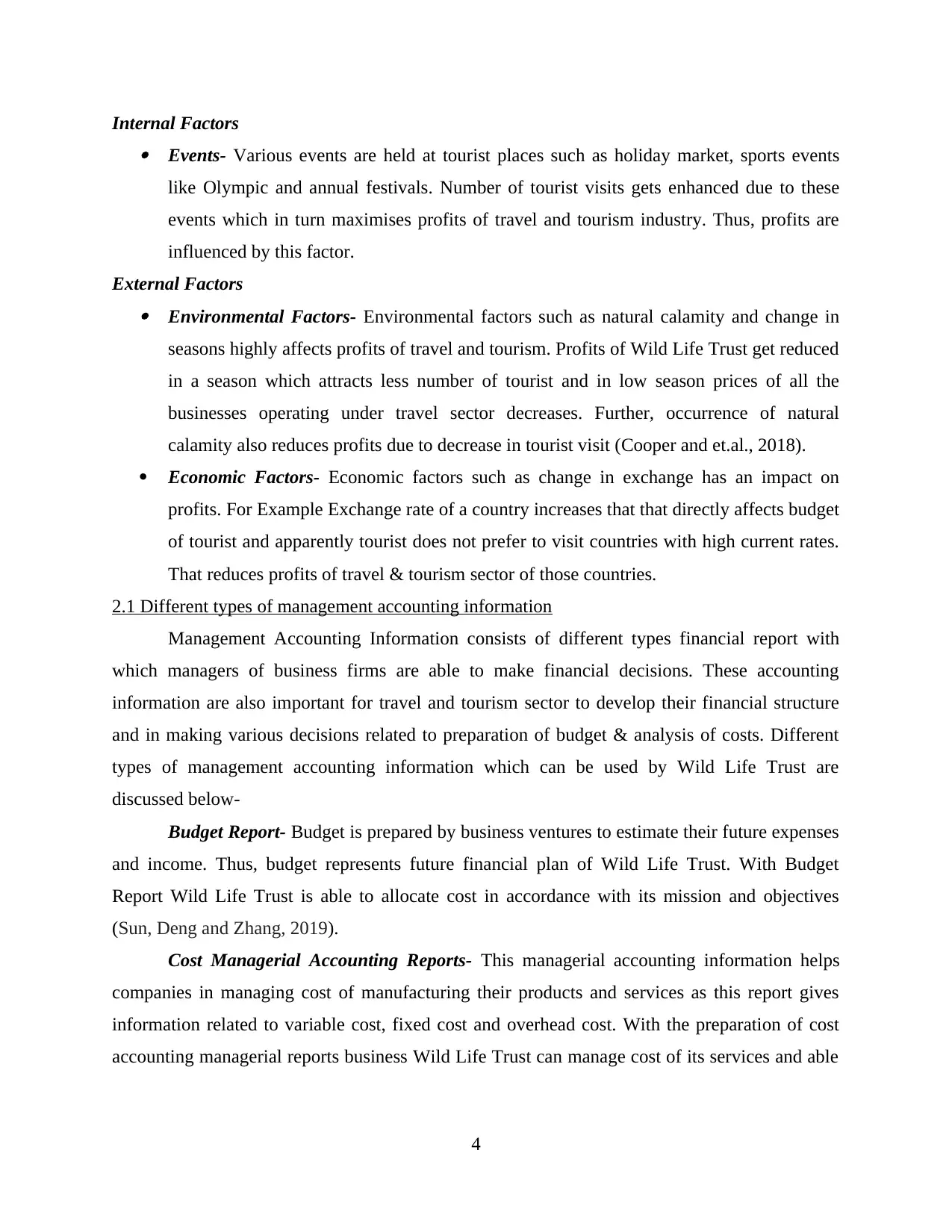
Internal Factors Events- Various events are held at tourist places such as holiday market, sports events
like Olympic and annual festivals. Number of tourist visits gets enhanced due to these
events which in turn maximises profits of travel and tourism industry. Thus, profits are
influenced by this factor.
External Factors Environmental Factors- Environmental factors such as natural calamity and change in
seasons highly affects profits of travel and tourism. Profits of Wild Life Trust get reduced
in a season which attracts less number of tourist and in low season prices of all the
businesses operating under travel sector decreases. Further, occurrence of natural
calamity also reduces profits due to decrease in tourist visit (Cooper and et.al., 2018).
Economic Factors- Economic factors such as change in exchange has an impact on
profits. For Example Exchange rate of a country increases that that directly affects budget
of tourist and apparently tourist does not prefer to visit countries with high current rates.
That reduces profits of travel & tourism sector of those countries.
2.1 Different types of management accounting information
Management Accounting Information consists of different types financial report with
which managers of business firms are able to make financial decisions. These accounting
information are also important for travel and tourism sector to develop their financial structure
and in making various decisions related to preparation of budget & analysis of costs. Different
types of management accounting information which can be used by Wild Life Trust are
discussed below-
Budget Report- Budget is prepared by business ventures to estimate their future expenses
and income. Thus, budget represents future financial plan of Wild Life Trust. With Budget
Report Wild Life Trust is able to allocate cost in accordance with its mission and objectives
(Sun, Deng and Zhang, 2019).
Cost Managerial Accounting Reports- This managerial accounting information helps
companies in managing cost of manufacturing their products and services as this report gives
information related to variable cost, fixed cost and overhead cost. With the preparation of cost
accounting managerial reports business Wild Life Trust can manage cost of its services and able
4
like Olympic and annual festivals. Number of tourist visits gets enhanced due to these
events which in turn maximises profits of travel and tourism industry. Thus, profits are
influenced by this factor.
External Factors Environmental Factors- Environmental factors such as natural calamity and change in
seasons highly affects profits of travel and tourism. Profits of Wild Life Trust get reduced
in a season which attracts less number of tourist and in low season prices of all the
businesses operating under travel sector decreases. Further, occurrence of natural
calamity also reduces profits due to decrease in tourist visit (Cooper and et.al., 2018).
Economic Factors- Economic factors such as change in exchange has an impact on
profits. For Example Exchange rate of a country increases that that directly affects budget
of tourist and apparently tourist does not prefer to visit countries with high current rates.
That reduces profits of travel & tourism sector of those countries.
2.1 Different types of management accounting information
Management Accounting Information consists of different types financial report with
which managers of business firms are able to make financial decisions. These accounting
information are also important for travel and tourism sector to develop their financial structure
and in making various decisions related to preparation of budget & analysis of costs. Different
types of management accounting information which can be used by Wild Life Trust are
discussed below-
Budget Report- Budget is prepared by business ventures to estimate their future expenses
and income. Thus, budget represents future financial plan of Wild Life Trust. With Budget
Report Wild Life Trust is able to allocate cost in accordance with its mission and objectives
(Sun, Deng and Zhang, 2019).
Cost Managerial Accounting Reports- This managerial accounting information helps
companies in managing cost of manufacturing their products and services as this report gives
information related to variable cost, fixed cost and overhead cost. With the preparation of cost
accounting managerial reports business Wild Life Trust can manage cost of its services and able
4
⊘ This is a preview!⊘
Do you want full access?
Subscribe today to unlock all pages.

Trusted by 1+ million students worldwide
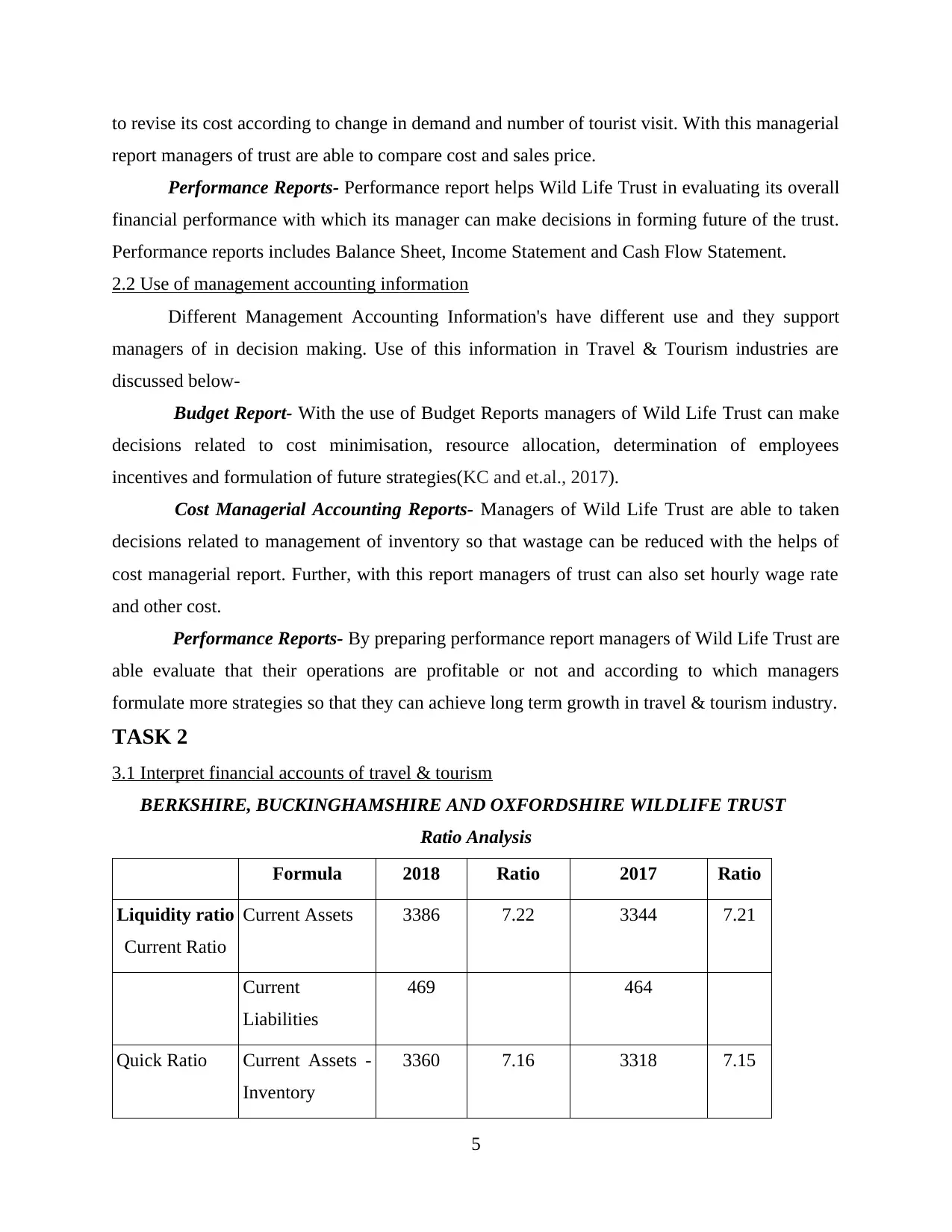
to revise its cost according to change in demand and number of tourist visit. With this managerial
report managers of trust are able to compare cost and sales price.
Performance Reports- Performance report helps Wild Life Trust in evaluating its overall
financial performance with which its manager can make decisions in forming future of the trust.
Performance reports includes Balance Sheet, Income Statement and Cash Flow Statement.
2.2 Use of management accounting information
Different Management Accounting Information's have different use and they support
managers of in decision making. Use of this information in Travel & Tourism industries are
discussed below-
Budget Report- With the use of Budget Reports managers of Wild Life Trust can make
decisions related to cost minimisation, resource allocation, determination of employees
incentives and formulation of future strategies(KC and et.al., 2017).
Cost Managerial Accounting Reports- Managers of Wild Life Trust are able to taken
decisions related to management of inventory so that wastage can be reduced with the helps of
cost managerial report. Further, with this report managers of trust can also set hourly wage rate
and other cost.
Performance Reports- By preparing performance report managers of Wild Life Trust are
able evaluate that their operations are profitable or not and according to which managers
formulate more strategies so that they can achieve long term growth in travel & tourism industry.
TASK 2
3.1 Interpret financial accounts of travel & tourism
BERKSHIRE, BUCKINGHAMSHIRE AND OXFORDSHIRE WILDLIFE TRUST
Ratio Analysis
Formula 2018 Ratio 2017 Ratio
Liquidity ratio
Current Ratio
Current Assets 3386 7.22 3344 7.21
Current
Liabilities
469 464
Quick Ratio Current Assets -
Inventory
3360 7.16 3318 7.15
5
report managers of trust are able to compare cost and sales price.
Performance Reports- Performance report helps Wild Life Trust in evaluating its overall
financial performance with which its manager can make decisions in forming future of the trust.
Performance reports includes Balance Sheet, Income Statement and Cash Flow Statement.
2.2 Use of management accounting information
Different Management Accounting Information's have different use and they support
managers of in decision making. Use of this information in Travel & Tourism industries are
discussed below-
Budget Report- With the use of Budget Reports managers of Wild Life Trust can make
decisions related to cost minimisation, resource allocation, determination of employees
incentives and formulation of future strategies(KC and et.al., 2017).
Cost Managerial Accounting Reports- Managers of Wild Life Trust are able to taken
decisions related to management of inventory so that wastage can be reduced with the helps of
cost managerial report. Further, with this report managers of trust can also set hourly wage rate
and other cost.
Performance Reports- By preparing performance report managers of Wild Life Trust are
able evaluate that their operations are profitable or not and according to which managers
formulate more strategies so that they can achieve long term growth in travel & tourism industry.
TASK 2
3.1 Interpret financial accounts of travel & tourism
BERKSHIRE, BUCKINGHAMSHIRE AND OXFORDSHIRE WILDLIFE TRUST
Ratio Analysis
Formula 2018 Ratio 2017 Ratio
Liquidity ratio
Current Ratio
Current Assets 3386 7.22 3344 7.21
Current
Liabilities
469 464
Quick Ratio Current Assets -
Inventory
3360 7.16 3318 7.15
5
Paraphrase This Document
Need a fresh take? Get an instant paraphrase of this document with our AI Paraphraser
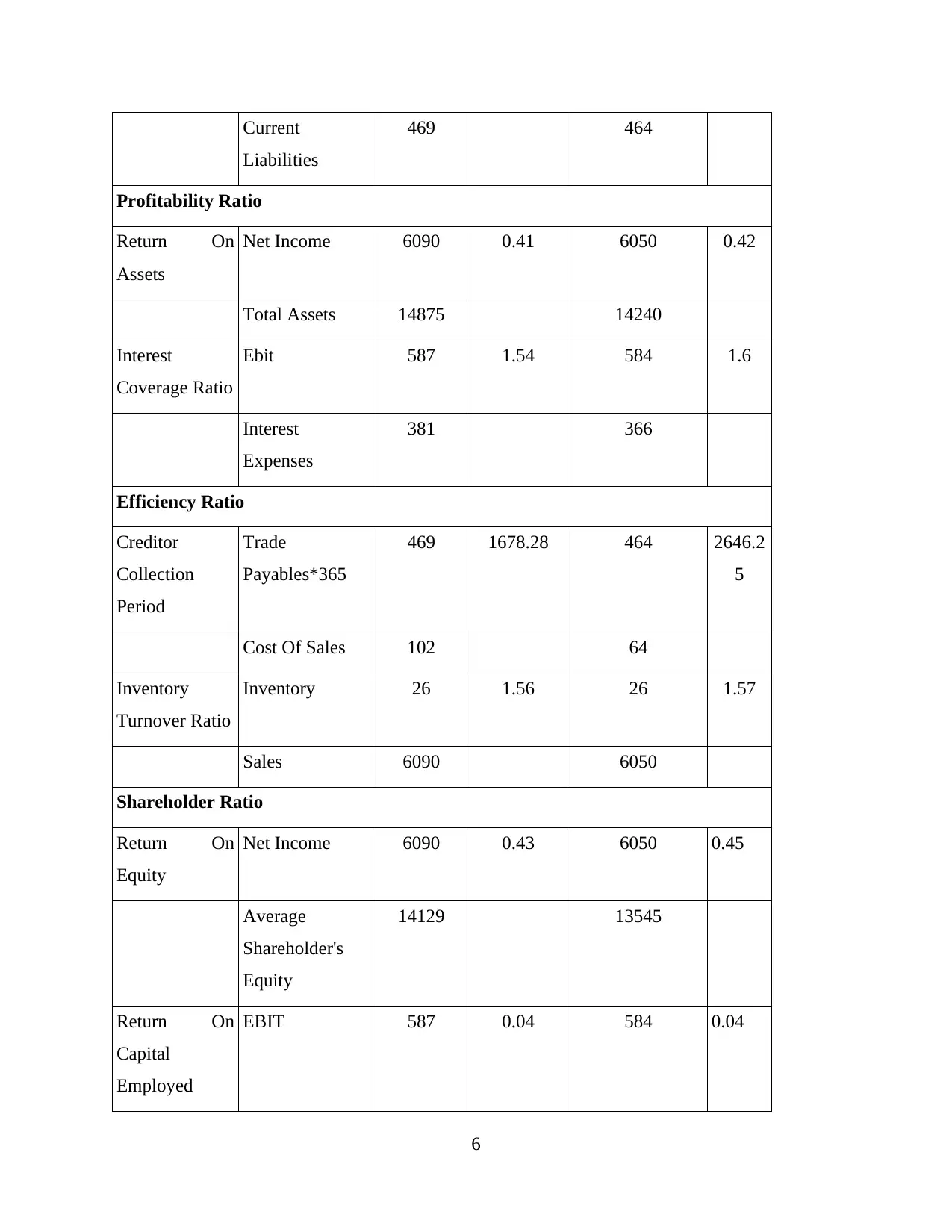
Current
Liabilities
469 464
Profitability Ratio
Return On
Assets
Net Income 6090 0.41 6050 0.42
Total Assets 14875 14240
Interest
Coverage Ratio
Ebit 587 1.54 584 1.6
Interest
Expenses
381 366
Efficiency Ratio
Creditor
Collection
Period
Trade
Payables*365
469 1678.28 464 2646.2
5
Cost Of Sales 102 64
Inventory
Turnover Ratio
Inventory 26 1.56 26 1.57
Sales 6090 6050
Shareholder Ratio
Return On
Equity
Net Income 6090 0.43 6050 0.45
Average
Shareholder's
Equity
14129 13545
Return On
Capital
Employed
EBIT 587 0.04 584 0.04
6
Liabilities
469 464
Profitability Ratio
Return On
Assets
Net Income 6090 0.41 6050 0.42
Total Assets 14875 14240
Interest
Coverage Ratio
Ebit 587 1.54 584 1.6
Interest
Expenses
381 366
Efficiency Ratio
Creditor
Collection
Period
Trade
Payables*365
469 1678.28 464 2646.2
5
Cost Of Sales 102 64
Inventory
Turnover Ratio
Inventory 26 1.56 26 1.57
Sales 6090 6050
Shareholder Ratio
Return On
Equity
Net Income 6090 0.43 6050 0.45
Average
Shareholder's
Equity
14129 13545
Return On
Capital
Employed
EBIT 587 0.04 584 0.04
6
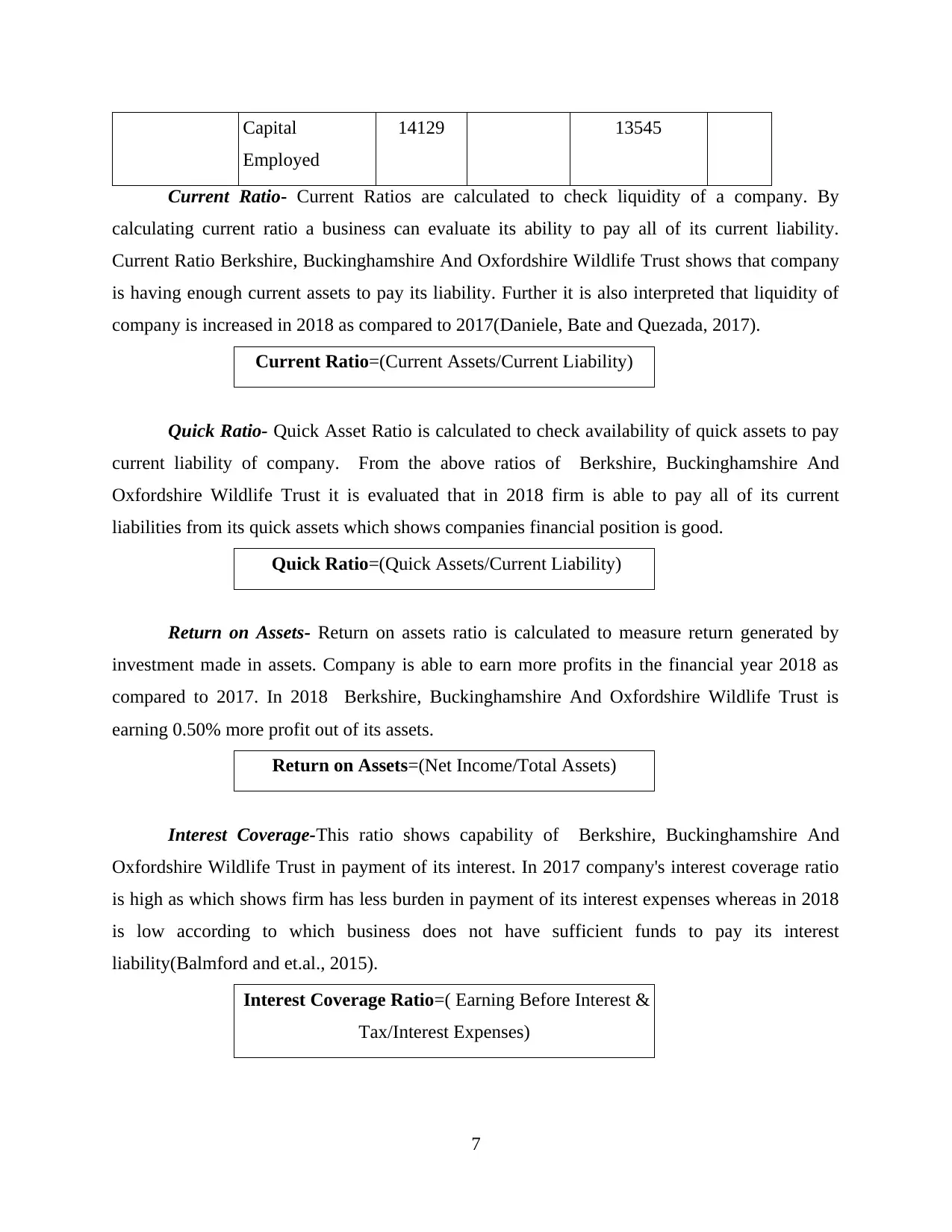
Capital
Employed
14129 13545
Current Ratio- Current Ratios are calculated to check liquidity of a company. By
calculating current ratio a business can evaluate its ability to pay all of its current liability.
Current Ratio Berkshire, Buckinghamshire And Oxfordshire Wildlife Trust shows that company
is having enough current assets to pay its liability. Further it is also interpreted that liquidity of
company is increased in 2018 as compared to 2017(Daniele, Bate and Quezada, 2017).
Current Ratio=(Current Assets/Current Liability)
Quick Ratio- Quick Asset Ratio is calculated to check availability of quick assets to pay
current liability of company. From the above ratios of Berkshire, Buckinghamshire And
Oxfordshire Wildlife Trust it is evaluated that in 2018 firm is able to pay all of its current
liabilities from its quick assets which shows companies financial position is good.
Quick Ratio=(Quick Assets/Current Liability)
Return on Assets- Return on assets ratio is calculated to measure return generated by
investment made in assets. Company is able to earn more profits in the financial year 2018 as
compared to 2017. In 2018 Berkshire, Buckinghamshire And Oxfordshire Wildlife Trust is
earning 0.50% more profit out of its assets.
Return on Assets=(Net Income/Total Assets)
Interest Coverage-This ratio shows capability of Berkshire, Buckinghamshire And
Oxfordshire Wildlife Trust in payment of its interest. In 2017 company's interest coverage ratio
is high as which shows firm has less burden in payment of its interest expenses whereas in 2018
is low according to which business does not have sufficient funds to pay its interest
liability(Balmford and et.al., 2015).
Interest Coverage Ratio=( Earning Before Interest &
Tax/Interest Expenses)
7
Employed
14129 13545
Current Ratio- Current Ratios are calculated to check liquidity of a company. By
calculating current ratio a business can evaluate its ability to pay all of its current liability.
Current Ratio Berkshire, Buckinghamshire And Oxfordshire Wildlife Trust shows that company
is having enough current assets to pay its liability. Further it is also interpreted that liquidity of
company is increased in 2018 as compared to 2017(Daniele, Bate and Quezada, 2017).
Current Ratio=(Current Assets/Current Liability)
Quick Ratio- Quick Asset Ratio is calculated to check availability of quick assets to pay
current liability of company. From the above ratios of Berkshire, Buckinghamshire And
Oxfordshire Wildlife Trust it is evaluated that in 2018 firm is able to pay all of its current
liabilities from its quick assets which shows companies financial position is good.
Quick Ratio=(Quick Assets/Current Liability)
Return on Assets- Return on assets ratio is calculated to measure return generated by
investment made in assets. Company is able to earn more profits in the financial year 2018 as
compared to 2017. In 2018 Berkshire, Buckinghamshire And Oxfordshire Wildlife Trust is
earning 0.50% more profit out of its assets.
Return on Assets=(Net Income/Total Assets)
Interest Coverage-This ratio shows capability of Berkshire, Buckinghamshire And
Oxfordshire Wildlife Trust in payment of its interest. In 2017 company's interest coverage ratio
is high as which shows firm has less burden in payment of its interest expenses whereas in 2018
is low according to which business does not have sufficient funds to pay its interest
liability(Balmford and et.al., 2015).
Interest Coverage Ratio=( Earning Before Interest &
Tax/Interest Expenses)
7
⊘ This is a preview!⊘
Do you want full access?
Subscribe today to unlock all pages.

Trusted by 1+ million students worldwide
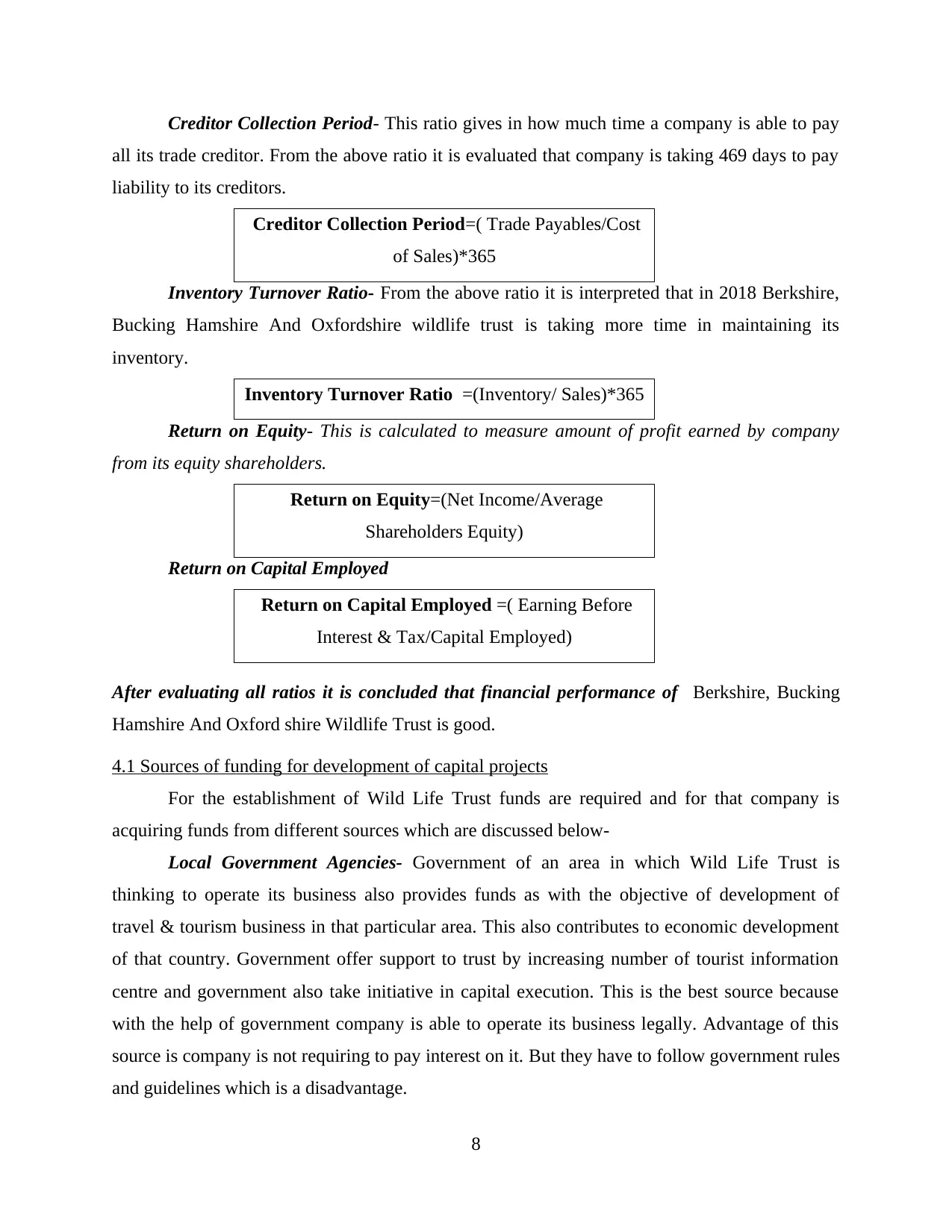
Creditor Collection Period- This ratio gives in how much time a company is able to pay
all its trade creditor. From the above ratio it is evaluated that company is taking 469 days to pay
liability to its creditors.
Creditor Collection Period=( Trade Payables/Cost
of Sales)*365
Inventory Turnover Ratio- From the above ratio it is interpreted that in 2018 Berkshire,
Bucking Hamshire And Oxfordshire wildlife trust is taking more time in maintaining its
inventory.
Inventory Turnover Ratio =(Inventory/ Sales)*365
Return on Equity- This is calculated to measure amount of profit earned by company
from its equity shareholders.
Return on Equity=(Net Income/Average
Shareholders Equity)
Return on Capital Employed
Return on Capital Employed =( Earning Before
Interest & Tax/Capital Employed)
After evaluating all ratios it is concluded that financial performance of Berkshire, Bucking
Hamshire And Oxford shire Wildlife Trust is good.
4.1 Sources of funding for development of capital projects
For the establishment of Wild Life Trust funds are required and for that company is
acquiring funds from different sources which are discussed below-
Local Government Agencies- Government of an area in which Wild Life Trust is
thinking to operate its business also provides funds as with the objective of development of
travel & tourism business in that particular area. This also contributes to economic development
of that country. Government offer support to trust by increasing number of tourist information
centre and government also take initiative in capital execution. This is the best source because
with the help of government company is able to operate its business legally. Advantage of this
source is company is not requiring to pay interest on it. But they have to follow government rules
and guidelines which is a disadvantage.
8
all its trade creditor. From the above ratio it is evaluated that company is taking 469 days to pay
liability to its creditors.
Creditor Collection Period=( Trade Payables/Cost
of Sales)*365
Inventory Turnover Ratio- From the above ratio it is interpreted that in 2018 Berkshire,
Bucking Hamshire And Oxfordshire wildlife trust is taking more time in maintaining its
inventory.
Inventory Turnover Ratio =(Inventory/ Sales)*365
Return on Equity- This is calculated to measure amount of profit earned by company
from its equity shareholders.
Return on Equity=(Net Income/Average
Shareholders Equity)
Return on Capital Employed
Return on Capital Employed =( Earning Before
Interest & Tax/Capital Employed)
After evaluating all ratios it is concluded that financial performance of Berkshire, Bucking
Hamshire And Oxford shire Wildlife Trust is good.
4.1 Sources of funding for development of capital projects
For the establishment of Wild Life Trust funds are required and for that company is
acquiring funds from different sources which are discussed below-
Local Government Agencies- Government of an area in which Wild Life Trust is
thinking to operate its business also provides funds as with the objective of development of
travel & tourism business in that particular area. This also contributes to economic development
of that country. Government offer support to trust by increasing number of tourist information
centre and government also take initiative in capital execution. This is the best source because
with the help of government company is able to operate its business legally. Advantage of this
source is company is not requiring to pay interest on it. But they have to follow government rules
and guidelines which is a disadvantage.
8
Paraphrase This Document
Need a fresh take? Get an instant paraphrase of this document with our AI Paraphraser
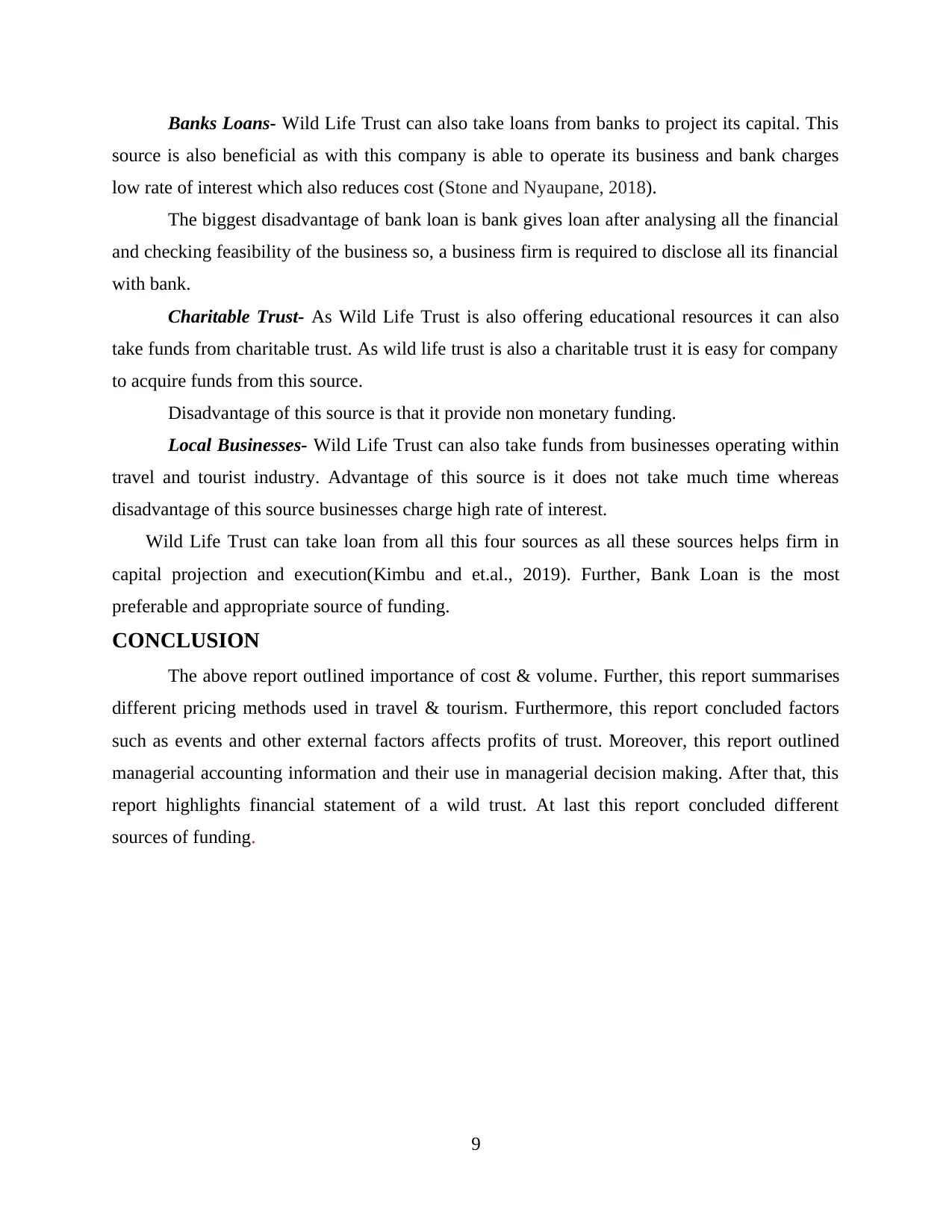
Banks Loans- Wild Life Trust can also take loans from banks to project its capital. This
source is also beneficial as with this company is able to operate its business and bank charges
low rate of interest which also reduces cost (Stone and Nyaupane, 2018).
The biggest disadvantage of bank loan is bank gives loan after analysing all the financial
and checking feasibility of the business so, a business firm is required to disclose all its financial
with bank.
Charitable Trust- As Wild Life Trust is also offering educational resources it can also
take funds from charitable trust. As wild life trust is also a charitable trust it is easy for company
to acquire funds from this source.
Disadvantage of this source is that it provide non monetary funding.
Local Businesses- Wild Life Trust can also take funds from businesses operating within
travel and tourist industry. Advantage of this source is it does not take much time whereas
disadvantage of this source businesses charge high rate of interest.
Wild Life Trust can take loan from all this four sources as all these sources helps firm in
capital projection and execution(Kimbu and et.al., 2019). Further, Bank Loan is the most
preferable and appropriate source of funding.
CONCLUSION
The above report outlined importance of cost & volume. Further, this report summarises
different pricing methods used in travel & tourism. Furthermore, this report concluded factors
such as events and other external factors affects profits of trust. Moreover, this report outlined
managerial accounting information and their use in managerial decision making. After that, this
report highlights financial statement of a wild trust. At last this report concluded different
sources of funding.
9
source is also beneficial as with this company is able to operate its business and bank charges
low rate of interest which also reduces cost (Stone and Nyaupane, 2018).
The biggest disadvantage of bank loan is bank gives loan after analysing all the financial
and checking feasibility of the business so, a business firm is required to disclose all its financial
with bank.
Charitable Trust- As Wild Life Trust is also offering educational resources it can also
take funds from charitable trust. As wild life trust is also a charitable trust it is easy for company
to acquire funds from this source.
Disadvantage of this source is that it provide non monetary funding.
Local Businesses- Wild Life Trust can also take funds from businesses operating within
travel and tourist industry. Advantage of this source is it does not take much time whereas
disadvantage of this source businesses charge high rate of interest.
Wild Life Trust can take loan from all this four sources as all these sources helps firm in
capital projection and execution(Kimbu and et.al., 2019). Further, Bank Loan is the most
preferable and appropriate source of funding.
CONCLUSION
The above report outlined importance of cost & volume. Further, this report summarises
different pricing methods used in travel & tourism. Furthermore, this report concluded factors
such as events and other external factors affects profits of trust. Moreover, this report outlined
managerial accounting information and their use in managerial decision making. After that, this
report highlights financial statement of a wild trust. At last this report concluded different
sources of funding.
9
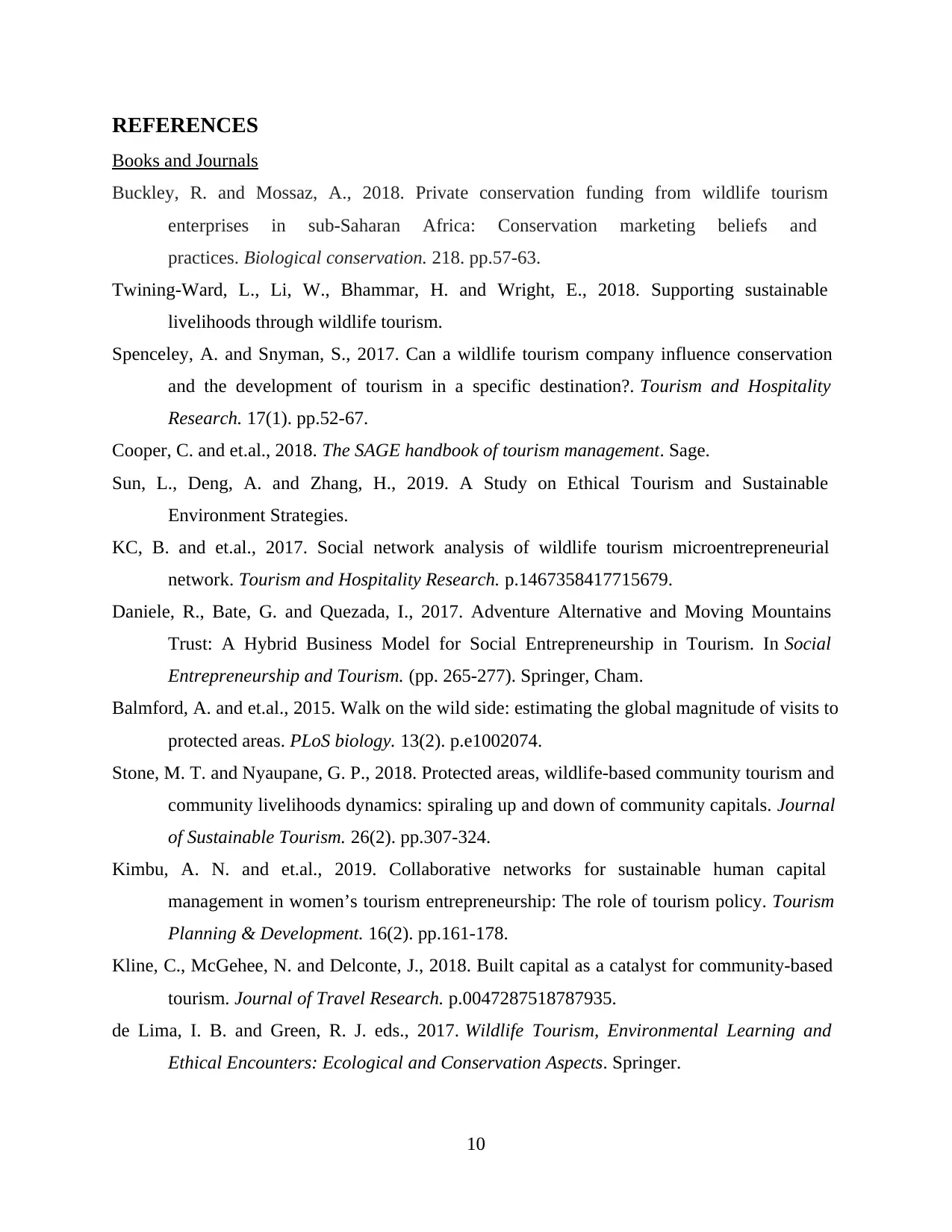
REFERENCES
Books and Journals
Buckley, R. and Mossaz, A., 2018. Private conservation funding from wildlife tourism
enterprises in sub-Saharan Africa: Conservation marketing beliefs and
practices. Biological conservation. 218. pp.57-63.
Twining-Ward, L., Li, W., Bhammar, H. and Wright, E., 2018. Supporting sustainable
livelihoods through wildlife tourism.
Spenceley, A. and Snyman, S., 2017. Can a wildlife tourism company influence conservation
and the development of tourism in a specific destination?. Tourism and Hospitality
Research. 17(1). pp.52-67.
Cooper, C. and et.al., 2018. The SAGE handbook of tourism management. Sage.
Sun, L., Deng, A. and Zhang, H., 2019. A Study on Ethical Tourism and Sustainable
Environment Strategies.
KC, B. and et.al., 2017. Social network analysis of wildlife tourism microentrepreneurial
network. Tourism and Hospitality Research. p.1467358417715679.
Daniele, R., Bate, G. and Quezada, I., 2017. Adventure Alternative and Moving Mountains
Trust: A Hybrid Business Model for Social Entrepreneurship in Tourism. In Social
Entrepreneurship and Tourism. (pp. 265-277). Springer, Cham.
Balmford, A. and et.al., 2015. Walk on the wild side: estimating the global magnitude of visits to
protected areas. PLoS biology. 13(2). p.e1002074.
Stone, M. T. and Nyaupane, G. P., 2018. Protected areas, wildlife-based community tourism and
community livelihoods dynamics: spiraling up and down of community capitals. Journal
of Sustainable Tourism. 26(2). pp.307-324.
Kimbu, A. N. and et.al., 2019. Collaborative networks for sustainable human capital
management in women’s tourism entrepreneurship: The role of tourism policy. Tourism
Planning & Development. 16(2). pp.161-178.
Kline, C., McGehee, N. and Delconte, J., 2018. Built capital as a catalyst for community-based
tourism. Journal of Travel Research. p.0047287518787935.
de Lima, I. B. and Green, R. J. eds., 2017. Wildlife Tourism, Environmental Learning and
Ethical Encounters: Ecological and Conservation Aspects. Springer.
10
Books and Journals
Buckley, R. and Mossaz, A., 2018. Private conservation funding from wildlife tourism
enterprises in sub-Saharan Africa: Conservation marketing beliefs and
practices. Biological conservation. 218. pp.57-63.
Twining-Ward, L., Li, W., Bhammar, H. and Wright, E., 2018. Supporting sustainable
livelihoods through wildlife tourism.
Spenceley, A. and Snyman, S., 2017. Can a wildlife tourism company influence conservation
and the development of tourism in a specific destination?. Tourism and Hospitality
Research. 17(1). pp.52-67.
Cooper, C. and et.al., 2018. The SAGE handbook of tourism management. Sage.
Sun, L., Deng, A. and Zhang, H., 2019. A Study on Ethical Tourism and Sustainable
Environment Strategies.
KC, B. and et.al., 2017. Social network analysis of wildlife tourism microentrepreneurial
network. Tourism and Hospitality Research. p.1467358417715679.
Daniele, R., Bate, G. and Quezada, I., 2017. Adventure Alternative and Moving Mountains
Trust: A Hybrid Business Model for Social Entrepreneurship in Tourism. In Social
Entrepreneurship and Tourism. (pp. 265-277). Springer, Cham.
Balmford, A. and et.al., 2015. Walk on the wild side: estimating the global magnitude of visits to
protected areas. PLoS biology. 13(2). p.e1002074.
Stone, M. T. and Nyaupane, G. P., 2018. Protected areas, wildlife-based community tourism and
community livelihoods dynamics: spiraling up and down of community capitals. Journal
of Sustainable Tourism. 26(2). pp.307-324.
Kimbu, A. N. and et.al., 2019. Collaborative networks for sustainable human capital
management in women’s tourism entrepreneurship: The role of tourism policy. Tourism
Planning & Development. 16(2). pp.161-178.
Kline, C., McGehee, N. and Delconte, J., 2018. Built capital as a catalyst for community-based
tourism. Journal of Travel Research. p.0047287518787935.
de Lima, I. B. and Green, R. J. eds., 2017. Wildlife Tourism, Environmental Learning and
Ethical Encounters: Ecological and Conservation Aspects. Springer.
10
⊘ This is a preview!⊘
Do you want full access?
Subscribe today to unlock all pages.

Trusted by 1+ million students worldwide
1 out of 16
Related Documents
Your All-in-One AI-Powered Toolkit for Academic Success.
+13062052269
info@desklib.com
Available 24*7 on WhatsApp / Email
![[object Object]](/_next/static/media/star-bottom.7253800d.svg)
Unlock your academic potential
Copyright © 2020–2025 A2Z Services. All Rights Reserved. Developed and managed by ZUCOL.





